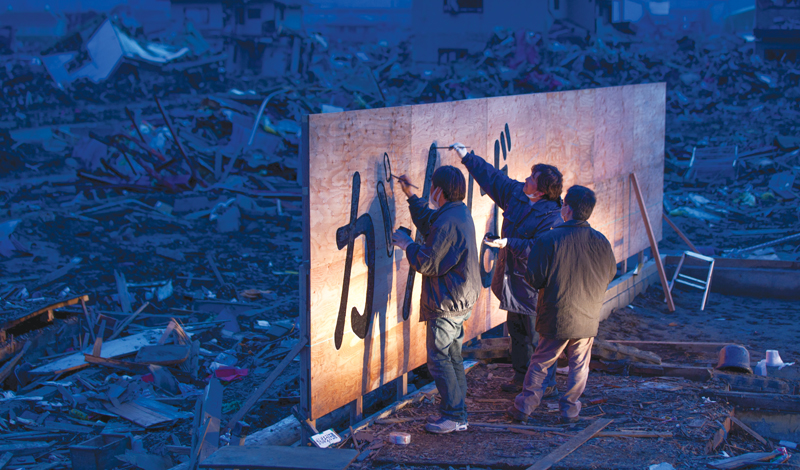Throughout 2025, the World Tribune is featuring on the cover historical acts by people that shifted public sentiment and even thawed tensions between nations. In this issue, we focus on the power of one person to give countless others hope.
During the devastating March 11, 2011, earthquake and tsunami in Northeastern Japan, Kenichi Kurosawa, a young man from Ishinomaki was swept up by the tsunami and escaped death by clinging to a pine tree throughout the night.
He lost his plumbing shop and home, and yet continued to support efforts to reestablish vital services throughout the city. On the ruins of his former home, he and his friends erected a huge sign on salvaged wood that read “Gambaro! Ishinomaki.” (Don’t give up, Ishinomaki!) The image of this sign raced throughout the world, and became an enduring symbol of the spirit of the people of Ishinomaki.
Ikeda Sensei, in a June 28, 2011, essay for The Japan Times, titled “The Courage to Rebuild,” wrote about this young man’s story, outlining three signs of hope amid the massive recovery efforts necessary to rebuild the devastated communities:
1) A sense of human solidarity: “Within the affected communities, a renewed and powerful spirit of cooperation is visible. When individuals stand up together in the face of a catastrophic challenge in this way, a dignified human community imbued with mutual care and support is born. No one should be left to suffer alone.” (July 29, 2011, World Tribune, p. 7)
2) The indomitable courage of those affected: “I was told of one woman from Kamaishi, Iwate Prefecture, who saved the lives of her neighbors. As the raging waters reached the second floor of her apartment building, she held on to an air-conditioning unit, meanwhile preventing a man carrying a baby from being swept away by pinning him against a wall with her back. With her free hand, she then grabbed and held onto another man by the collar. She said she was determined not to let them go even if her arms were torn off.” (Ibid.)
3) The passion and vigor of youth taking action: “Young people are, by their very youth, the embodiment of hope. No matter how dark it is, the sun rises where young people take a stand.” (Ibid.)
Sensei continues: “The path toward full reconstruction will be long. But we will continue to move forward, inspired by the example of such courageous youth, joining forces with others exerting themselves for the recovery of the affected communities.
“Each step, no matter how seemingly small, will help plant the seeds of hope and be counted among the treasures of the heart.
“The spirit of the people of Tohoku is found in these further words of Kan’ichi Asakawa: ‘People are not so weak that they can only live under the sway of their circumstances … Rather than be crushed by sorrow, let us rise proudly above it.’” (Ibid.)
Today, the people of Ishinomaki renew the sign every five years, involving the community’s children in constructing it. Not only does it serve to pass on the memory of the disaster, but the very spirit of Ishinomaki’s people at the time, reminding all who see it that such a spirit resides in them—the indomitable strength to never, ever give up.
—Prepared by the World Tribune staff
You are reading {{ meterCount }} of {{ meterMax }} free premium articles

